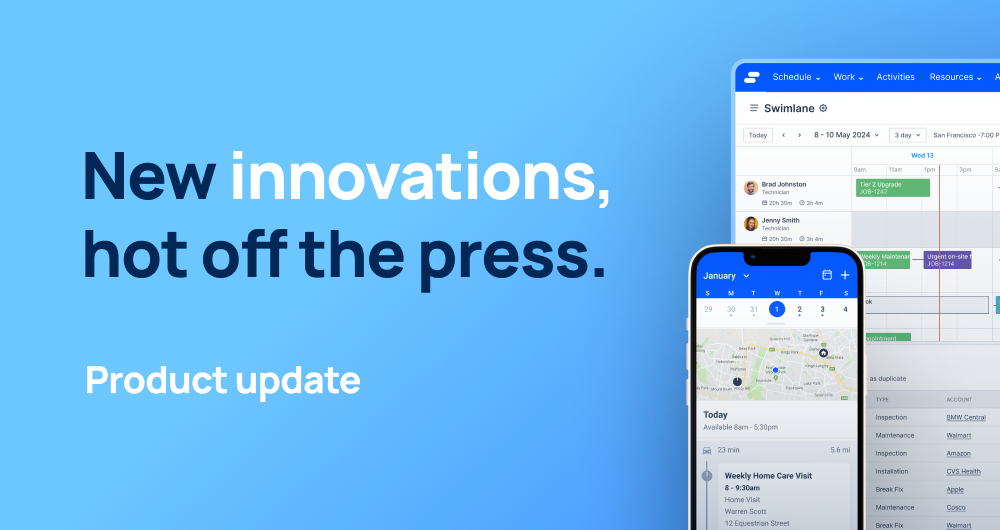How to Improve the Healthcare Revenue Cycle
The revenue cycle is, of course, essential to the success of any healthcare organization and its patients. But poor management of the revenue cycle negatively influences the health and financial wellness of customers as well as the revenue, growth, and operations of the business itself.
Inadequate tools and manual processes hinder the company’s ability to optimize the revenue cycle. And while this can be problematic in any industry, it’s particularly detrimental to organizations in healthcare That’s because they depend on accurate, efficient revenue cycles to remain profitable and viable, and therefore able to provide excellent patient care
Improving this cycle with up-to-date software and practices can result in better quality of care and quality of life for all parties involved; and getting it right requires tools that enable patient self-service, efficient scheduling, intelligent analytics, and seamless collection of and access to data.
Understanding the Healthcare Revenue Cycle
The healthcare revenue cycle refers to all of the activities associated with receiving payments for service, from scheduling, to insurance and eligibility verification, to delivery of care, to collection of payment. While the exact revenue cycle may vary from one healthcare organization to the next, most companies follow a common progression:
- Patient scheduling – Once a patient requests a service, an appointment is scheduled. This can be done through a self-service patient portal or an administrative staff scheduler, who will collect their information to match them with the right provider.
- Insurance and eligibility verification – Before the provider delivers care, a staff administrator will gather the patient’s insurance information and determine their coverage eligibility.
- Charge capturing and coding – Each patient service corresponds to a medical code, which administrators then transcribe into a billable charge. Insurers use medical codes to establish reimbursement amounts.
- Claims generation and submission – After coding a patient’s services, administrators send a claim to the patient’s insurance company for verification and approval.
- Payment collections – If a patient’s claim is approved, the insurance company will reimburse the healthcare provider based on eligibility. If the claim is denied—or if there are any additional, outstanding costs—the provider must contact the patient to collect the payment.
What is Revenue Cycle Management?
Tracking the myriad moving parts within the healthcare revenue cycle can be quite complex, especially as an organization scales. Without the proper processes and tools, key details can fall through the cracks, leading to errors that delay provider reimbursement. To avoid missteps, healthcare organizations need an effective revenue cycle management (RCM) practice. RCM is the process of managing all of the operational functions related to the business’s revenue cycle.
The performance of a healthcare business is directly connected to the quality of their revenue cycle management. RCM ensures a steady and accurate flow of information and communication across each step of the cycle, so it runs like a well-oiled machine. Effective RCM also helps maximize claim reimbursement, so the business can boost revenue without having to increase the cost of service to its patients. A strong RCM process eases administrative burdens (like spelling errors, typos, etc.), increases hospital revenue, decreases the likelihood of claim denial, and helps the organization avoid both healthcare and patient fraud.
To reap these benefits, healthcare organizations need RCM software that ties everything together. These systems automate many of the tasks involved in the revenue cycle process, including billing and collections. When paired with a sophisticated scheduling solution, RCM software can help businesses circumvent lagging or missed revenue and positively impact their overall health and profitability.
Challenges of The Healthcare Revenue Cycle
The importance of a healthy, streamlined revenue cycle is clear; so why do so many healthcare organizations still struggle to get it right? The reality is that many haven’t yet leveraged the proper strategies or tools for support.
In fact, 90% of healthcare providers still use paper and manual processes for patient data collection. It’s a time-exhaustive, inefficient, and mistake-laden method that creates challenges in a variety of areas across the revenue cycle, including:
- Patient scheduling – Manual patient scheduling methods simply slow down the healthcare revenue cycle. It’s time-consuming and error-prone for administrators to receive a patient appointment request, manually match that patient to the right provider (based on location, qualifications, patient history, etc.), and verify the apportionment. Re-entering appointment data into several systems of record is equally time-intensive and vulnerable to human error, and increases the number of leakage points across the cycle—especially as the organization scales.
- Collection of payments – 77% of providers say it takes more than a month to collect any payment. It’s a delay caused by manual data capture and re-entry into systems, patient misunderstanding of coverage versus individual responsibility, and complex scheduling and billing processes. Without the right technology, collecting reimbursements from insurance companies and payments from patients is often a tiresome nightmare; and one that’s riddled with high rework and claim denial percentages. An inability to efficiently collect payments can, over time, make it difficult for a healthcare organization to continue treading water without driving up its costs of service.
- Chart documentation errors – Patient charts are essential, both for documenting care requirements and prescribed services as well complying with legal requirements. Chart documentation errors can result in inaccurate, low-quality data, which can—in turn—negatively impact patient care and claims reimbursement revenue. Some healthcare organizations have adopted specific programs, like clinical documentation improvement (CDI), in an effort to boost documentation accuracy, ensure proper claims submissions, improve patient outcomes, and reduce the chance for unfavorable audits. But lack of team-wide training and resources on standards and inadequate documentation tools threaten their ability to reduce human error. This is especially true for organizations that still rely on paper-based documentation methods, as misinterpreted handwriting, incomplete notes, and transcription errors can make it difficult to properly plan for patient care or prove the delivery of services for insurance billing purposes.
- Coding errors – There are several different coding errors that can turn into costly mistakes for your healthcare organization, including upcoding, unbundling, and undercoding. Many healthcare companies have neglected the importance of investing both in education around proper coding methods and in sophisticated tools that automate and verify the process. But insufficient training and lackluster software don’t do much in the way of helping prevent coding errors, and an inability to catch them before claim submission causes high denial rates that impact reimbursement and, thus, revenue.
- Changes to regulatory practices and compliance – Remaining compliant with ever-evolving laws, policies, and regulations around healthcare billing and reimbursement is often a significant challenge for healthcare organizations. It’s especially difficult when the organization’s departments work in silos, with a separate focus on singular functions. For example, care providers likely prioritize patient outcomes, while administrative and operational staff fixate on collecting and increasing revenue. Without the education, processes, and systems in place to ensure compliance is at the heart of patient data entry, care delivery, and other activities within the revenue cycle, regulatory changes can quickly result in costly noncompliance penalties.
5 Strategies to Improve the Healthcare Revenue Cycle
Improving healthcare revenue cycle management requires a few major shifts in strategy. These changes are well-worth the required investment of time and budget, as boosting RCM efficiency and efficacy can lead to better patient experiences, increased staff productivity, and a healthier bottom line.
Here are five key strategies your organization can leverage for greater RCM success:
1. Leverage intelligent scheduling software
Efficient patient scheduling is a vital part of the revenue cycle and the organization’s operational health. Matching each patient to the right provider (based on skills, qualifications, patient history, etc.) is a complex, error-prone process if administrators rely on paper-based, manual methods—and this outdated approach typically requires repetitive data re-entry into other systems of record.
Intelligent, automated scheduling software can make the process more accurate and seamless, and eliminate the extra step of re-entering patient and appointment data into separate systems. Some tools automatically match patients to the appropriate provider, so staff schedulers don’t waste time digging through patient records and caregiver details to schedule each visit.
As the organization scales and patient rosters grow, robust scheduling technology easily handles the myriad details surrounding scheduling, so administrators can focus on other revenue-generating tasks. With the right software, all of this data is instantly and securely shared across critical systems, so eligibility verification, claims submission, billing, and payment collection are managed with accuracy and ease.
When a patient requests a care appointment, the staff scheduler can instantly field the request in a single, centralized platform that shows them all the up-to-date details they need to schedule the visit. They can see the patient’s previous appointment history, whether or not the requested appointment type is recognized by the patient’s insurance company, and any qualified providers who are available for the visit.
Modern scheduling software even enables batch optimization, so administrators can easily ensure eligibility of coverage prior to care delivery; which protects revenue that might otherwise be lost or delayed by a claim denial. Schedulers can access co-payment amounts, then send notifications of those amounts to patients before their arrival (or past-due notifications post-visit) to ensure timely payment. Up-front, transparent information regarding individual payment responsibility results in better patient engagement and satisfaction, as well as faster collection.
Automated scheduling also helps healthcare organizations maximize the number of patients their caregivers are able to serve. By optimizing their caregivers’ schedulers (based on predetermined objectives), businesses ensure less provider downtime without risking premature employee burnout or subpar quality of care. The result is a more efficient, productive, and profitable team that can create and execute on pre-verified, revenue-protected schedules.
2. Use advanced analytics
Most healthcare companies are well aware of the importance of data when it comes to identifying trends and patterns and making informed decisions to improve business outcomes. Yet many still lack the breadth and quality of data needed across every critical function to drive truly meaningful improvements.
If your organization hasn’t yet leveraged advanced data analytics as part of its revenue cycle management strategy, it may be time to consider how that lack of deep analysis and understanding might be holding you back. Data analytics can play an enormous role in optimizing the RCM process; from scheduling, to eligibility verification, to medical coding, to claim submissions, and, of course, payment collections.
With robust analytics tools, operations teams can quickly discover problem areas within the revenue cycle and fix them before they become larger issues. Since modern platforms connect and analyze data from various critical sources (e.g. your finance software, HR and payroll systems, EHR technology, scheduling platform, and more), then generate easy-to-read reports, your team can rest easy knowing they’re working from the best, most up-to-date information possible at any given time.
And as regulations continue to change, analytics can help your business ensure price transparency and quality care with patients, more accurately predict claim results, and gain insights into further revenue opportunities moving forward—all while maintaining compliance.
3. Keep forms simple and customer-centric
Some surveys show that more than half of Americans are confused by health insurance; a staggering fact that may shed light on delayed (or completely lost) patient payments. By offering up-front price transparency, providers can help mitigate some of that confusion, but that still leaves revenue on the table in the form of claim denials.
To keep patients engaged while also reducing the risk for denials, healthcare organizations should develop and leverage simple, patient-friendly forms through the end-to-end care delivery process. Scheduling, insurance, and billing should be as easy as possible for patients so as to avoid errors that might defer claim approval and reimbursement. Businesses should operate under the assumption that their patients do not have deep knowledge around their own financial responsibility versus that of their insurers’, nor the time to fill out overly complicated, lengthy forms.
4. Invest in user-friendly mobile interfaces
Another way to ensure convenience and engagement (for patients and providers alike) is to leverage user-friendly mobile interfaces for data capture. Some mobile platforms allow patients to register, self-schedule their care appointments, access their previous care history, provide insurance information and consent signatures, and even pay their remaining balance.
Plus, since everything is conducted and collected in a single, centralized place, providers always have seamless access to patient schedules and medical histories, preferences, and more—which empowers them to provide the best care possible. With the right mobile-friendly platform, healthcare organizations can even automate the medical coding and insurance verification processes, which saves time otherwise spent re-entering and confirming that data in a separate system.
For instance, a patient can request an appointment through the provider’s website, where they enter their symptoms, pertinent medical history, insurance information, and any other necessary patient details. Then, a staff scheduler can instantly verify the patient’s coverage eligibility, match the patient to an appropriate, qualified provider, and provide them with an accurate estimate of their individual financial responsibility.
After the patient’s visit, administrators can send a billing alert to the patient with the press of a button, and the patient can provide payment through the same mobile interface they initially used to book the appointment. It’s a seamless experience for both the provider and patient, and one that enables the organization to ultimately collect more revenue in a timely manner.
5. Ensure real-time accountability
Understanding where your employees are, what they’re doing, and what tasks they’re supposed to complete next is crucial for maintaining operational control while empowering staff to be accountable for their work. It’s also vital for optimizing the overall revenue cycle, since accurately scheduling, recording, completing, and billing services is what drives your stream of revenue.
This requires complete transparency of your workforce, which is often a struggle for healthcare companies, particularly those with a mobile or blended workforce, like home healthcare organizations. Keeping track of a dynamic team of providers (along with patient details, appointment information, and other essential data) can quickly turn into an uphill battle without the proper tools. And ensuring accountability means more than just verifying that your providers deliver the right services when and where they’re supposed to: It also means offering consistent, quality care and accurate billing practices.
Powerful software solutions can help your business build a culture of accountability, with automated invoicing, seamless incident management, and total visibility into workforce operations. Supervisors and schedulers can track providers’ progress in real-time through location tracking, status updates on appointments, and notifications of any schedule changes as they occur. Providers have instant access (regardless of where they are) to patient information and the tools they need to deliver excellent patient experiences.
For example, a home healthcare provider is better prepared to answer their patient’s questions when they have real-time access to the patient’s appointment and medical history through their centralized mobile app. Once the visit has been completed and the provider has added data from the appointment (like care details, services provided, patient signatures, etc.), an administrator can accurately create a claims submission and complete the charge capture process for reimbursement and patient payment.
Then, armed with those insights, the organization is better equipped to make data-driven decisions that improve the revenue lifecycle and patient satisfaction in the future. In this way, both sides of the business work together to improve accountability for better profitability, a more empowered workforce, and happier patients.
Optimized Scheduling for a Streamlined Healthcare Revenue Cycle
Ensuring a successful process requires the right software for support. While manual tools and outdated strategies won’t cut it, modern solutions can better empower your business to increase revenue without sacrificing quality patient care.
Skedulo’s intelligent healthcare scheduling platform can elevate your business’s revenue cycle. With tools that automate scheduling, instantly match the right provider to the right patient, generate actionable reports, collect field data in real-time, and ensure accountability, Skedulo can help your team increase caregiver efficiency and boost overall revenue.
Learn more about how Skedulo can empower your healthcare organization to succeed, or book a demo today.




